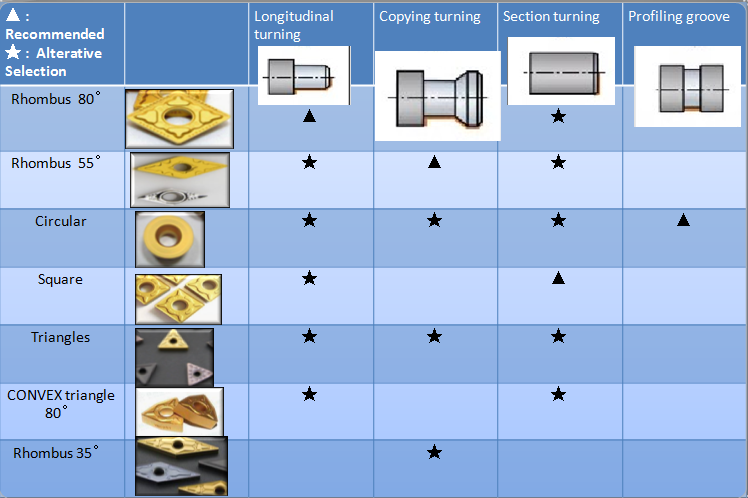Choose a general-purpose guide.
- The reliable clamping of the blade and the tool holder is the basic premise to keep the stability in turning.
- The handle type is determined by the primary offset angle, shape, and size of the blade used.
- The selection of the tool holder system is mainly based on the type of working procedure.
- Another important choice is whether to use a negative or positive rake blade.
- Choose modular tools whenever possible.

Guide for selection of cylindrical turning inserts

Four main areas of application
One
Longitudinal turning/end turning
The most common turning process
- A diamond-shaped c-80° blade commonly used.
- Hilts with the main declination angles 95° and 93°, and Angle of entry-5° and-3° widely used.
- The replacement options for type C are type D 55°, type W 80°, and type T 60°.

Two
Copying cutting
Generality and accessibility are the determining factors
- To obtain satisfactory machining results, the effective central deflection angle Kapr cut-in Angle Psir should be considered.
- The most commonly used central deflection angle is 93°, and the Angle of entry is-3° because it allows for an internal profiling angle of 22°-27°.
- The most widely used blade shapes are d-55° and v-35°.

Three
End Turning
The cutter feeds along the Radial Direction
- Note the cutting speed, which will change gradually as the feed goes along the radial direction.
- The standard principal declination angles are 75° and 95° / 91°, and the Angle of entry is 15° and-5° /-1°.
- c-80° and s-90° blades commonly used.

Four
Profile cutting
A method of machining or widening a shallow groove
- The circular blade is ideal for inserting vehicles because it can use for both radial and axial feed.
- A round edge with 90° handles commonly used.

Benefits of large and small principal declinations
One
Benefits of a large deflection angle
The Angle of large principal deflection and small Angle of entry
- The cutting force directed to the chuck
- capable of shoulder turning
- higher cutting force when cutting in and out of the workpiece
- Wear and tear of grooves is prone to occur in the processing of superalloys and hard materials

Two
Benefits of small principal declination
Small Main Deflection, large Angle of entry
- The chips produced are thinner
- productivity growth
- groove wear reduced
- the shoulder can not turn

Central deflection angle and profile angle
- In profiling turning, the cutting conditions vary with the depth, chip thickness, degree, and cutting speed.
- Choose the maximum blade angle suitable for the blade to ensure strength and cost-efficiency. Still, the blade accessibility must also be considered when considering the blade angle to ensure proper clearance between the material and the cutting edge.
- The most commonly used knife points are 55° and 35°.
- Both the central deflection /Angle of cut and the Angle of tooltip are essential factors affecting accessibility. Choose the most suitable profile angle; the profile of the workpiece must be analyzed.
- A minimum of 2° corners of avoidance must be maintained between the workpiece and the blade.


Axial and radial cutting forces
One
Large central deflection angle (small Angle of entry)
- The cutting force directed to the chuck. Vibration trend reduction.
- Higher cutting forces, especially when cutting in and out of the workpiece.

Two
Small Main Deflection Angle (large Angle of cut)
- The cutting force distributed along with both axial and radial directions.
- Reduced load on the cutting edge.
- The cutting power distributed along with both axial and radial directions.
- Vibration trend.


Leave A Comment